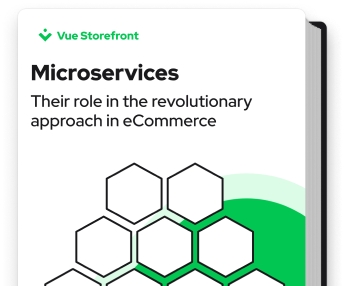Explore by Category:
Microservices
Microservices examples: Popular patterns and real-life eCommerce success stories
Cloud computing and cloud architecture for software applications have been game-changers. With the co-emergence of microservices, development processes are simplified, allowing for greater focus and productivity.
At the same time, microservices are one of the most overused terms in IT blogging throughout most IT industries. The word is often used without rhyme or reason, causing unnecessary confusion among business leaders and decision-makers.
This blog will clarify:
- The definition of Microservice Architecture
- Microservices examples of design patterns
- The business benefits of microservices in eCommerce
- Enterprise microservices examples of successful deployments
The definition of microservice architectures
In a nutshell, microservice architecture is a loose framework of orchestrating services that perform just one action. Microservices structures an application as a collection of services that are:
- Loosely coupled and communicates via APIs
- Highly maintainable and testable
- Independently deployable
- Organized around business capabilities
The collection of modules is like a LEGO construction kit. You dedicate each service to specific company objectives. The single-responsibility principle is the core of microservices.
The API (application program interface) unites the various services by allowing them to communicate with each other. This approach allows for much freedom in terms of the services’ relative independence from one another, which makes development and upkeep much more straightforward.
An architecture designed for microservices is the best option in situations where your system’s primary requirement is agility and scalability. You can also launch brands and experiences incrementally, leading to continuous innovation and optimization.
Read more about monolithic vs. microservices here.
Microservices examples of architecture patterns
Another essential element of the microservice architecture pattern is that it is a distributed system, which means that all components are completely decoupled and accessed through a remote access protocol (e.g., RMI, REST, JMS, AMQP, SOAP). This architecture pattern’s distributed nature is one of its major strengths.
Principles for designing architectures for microservices
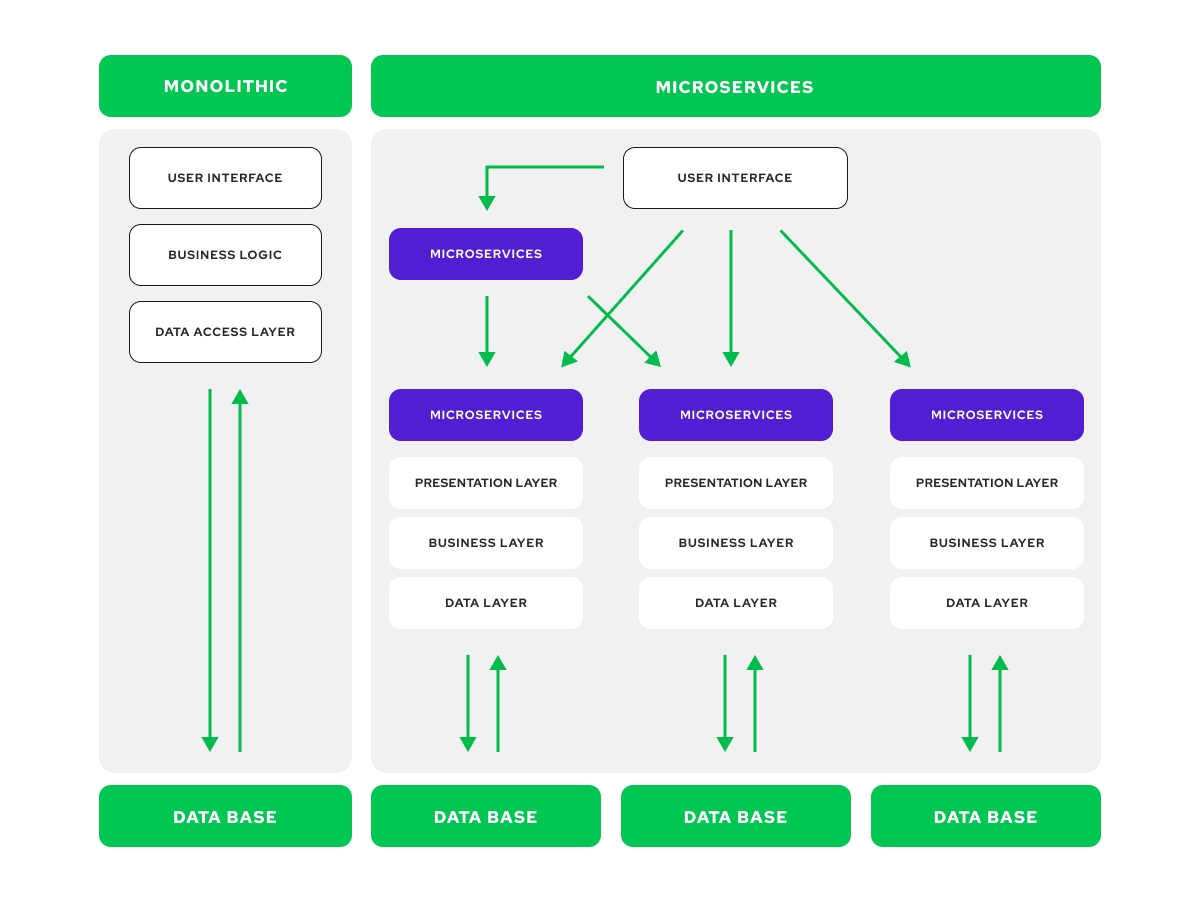
1. Single responsibility: To achieve the best service-oriented architecture, each microservice has a single focus and delivers a single service.
2. Built around business capabilities: Each microservice may utilize a different technology based on business needs.
3. Designed for failure: If one microservice encounters an error it does not impact any others.
One of the fascinating aspects of this architecture is that it evolved from issues with other popular architecture patterns rather than being devised as a cure for a problem. The microservice design style emerged from two primary origins:
1. Monolithic applications built using the layered architecture pattern
The layered architecture pattern is based on the n-tier structure. Each layer has a set of responsibilities that define how the application performs its tasks and interactions. The components are organized into horizontal layers, with each layer performing a distinct function within the application (e.g., business logic or presentation logic). Most layered architectures include four standard layers: presentation, business, persistence, and database.
2. Distributed applications generated utilizing the service-oriented architecture approach
The service-oriented architecture combines distributed, independently maintained, and deployed software components. The ability to communicate and collaborate over a network, especially an IP network, is enhanced by technologies and standards facilitating components' communication and cooperation.
Microservices examples of architecture patterns are:
- The Strangler Pattern
- The Event Sourcing Pattern
- The API Gateway Pattern
- The SAGA Patterns
Microservices architecture example: The Strangler Pattern
The Strangler Pattern is where an “old” system is hidden behind an “invisible” facade. Over time, external replacement services for the old system are built on top of the facade.
- The function of each facade is to represent the system’s existing entry points.
- The old system still has some influence.
- Calls to the previous system pass through the facade.
- New services are created from the old system’s services, which are refactored.
- The intermediary facade is modified to route calls formerly destined for the old system’s service to the new one after a new service is established.
- The old services eventually get “strangled” in favor of the new ones
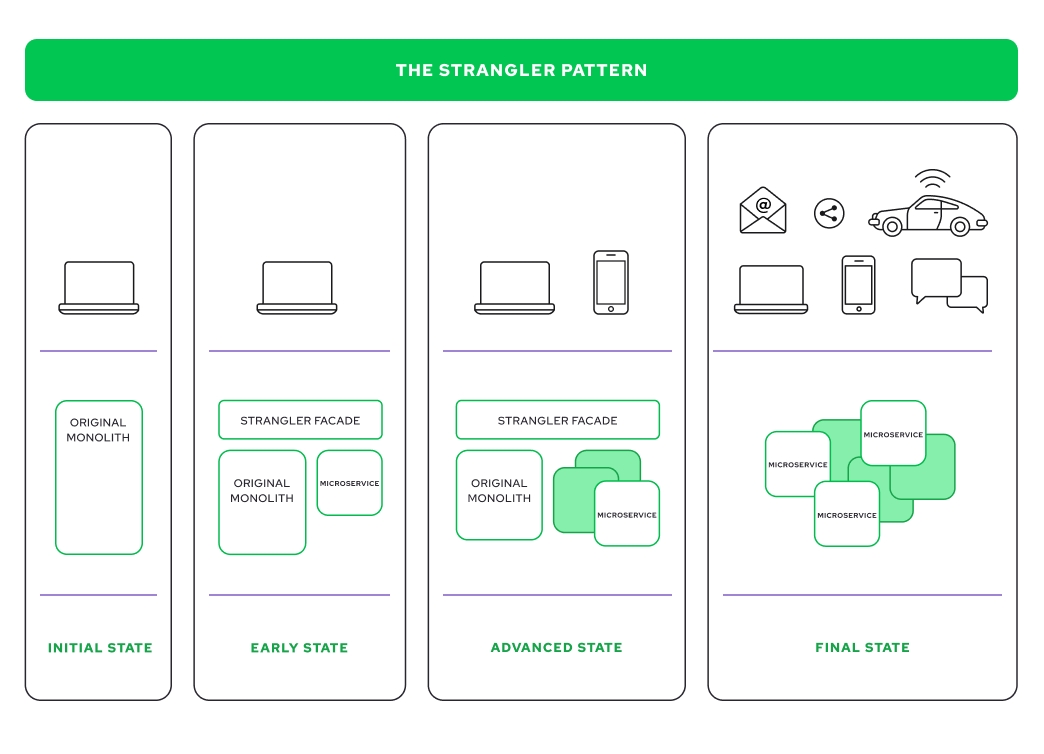
Certain services do not need to be migrated during the migration process. These include any applications or services with restrictions on usage, such as those belonging to an eCommerce platform.
By adding new features and refactoring existing ones, you can make sure that your site offers greater value for visitors than ever before while maintaining full functionality.
When you’re performing a system transformation, it allows you to reduce risk and maintain existing applications while migrating to new versions.
The Event Sourcing Pattern
The event sourcing generates a new chronological sequence of events. Recreating the application’s state involves querying the data, and to do so, you must remap every change to the application’s state. The concept that the system should record any modification to an entity’s state underpins Event Sourcing.
A business item’s persistence is maintained by recording a series of state-altering occurrences.
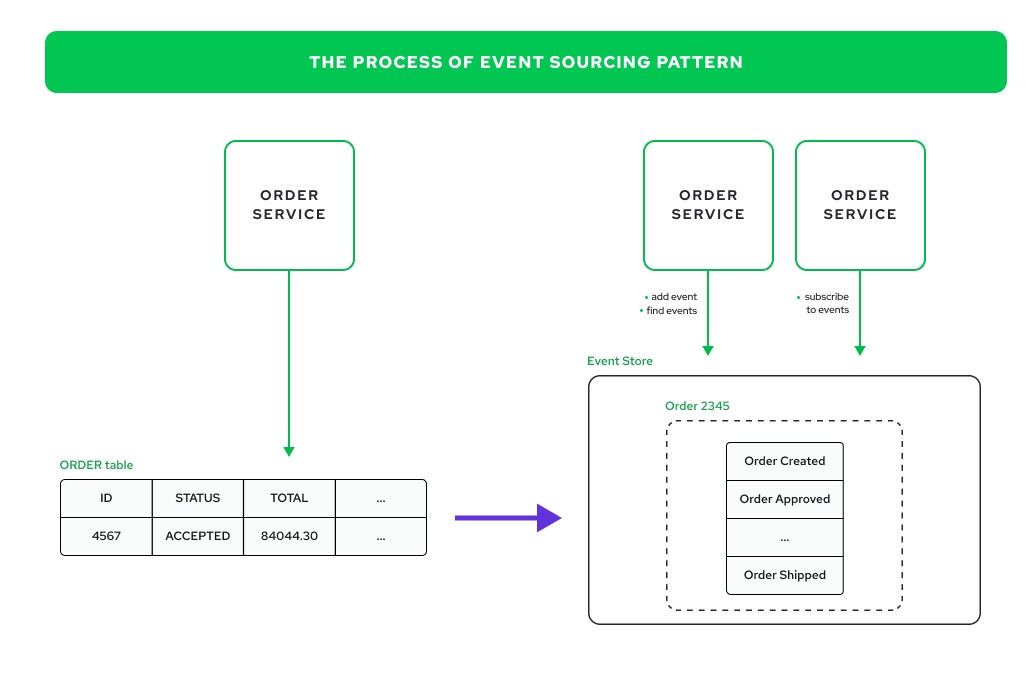
Every time an object’s state changes, a new event is added to the sequence of events. It’s essentially one action. Its present condition may be reconstructed by replaying its occurrences.
An event store keeps track of all events and serves as a message broker and a database of events. This enables services to register for events via an API. All interested subscribers are notified about each event stored in the event store’s database. The event store is the base of an event-driven microservices architecture.
The Event Sourcing Pattern is excellent to use when:
- It’s imperative that you retain the current data storage
- You don’t want any changes to your existing data layer codebase
- Your transactions are critical to your application’s success
Microservices architecture example: API Gateway
The API Gateway aims to provide a single entry point for a set of microservices. It’s excellent for big applications with several client apps, and it’s responsible for delivering a unified entrance point for a specific group of microservices.
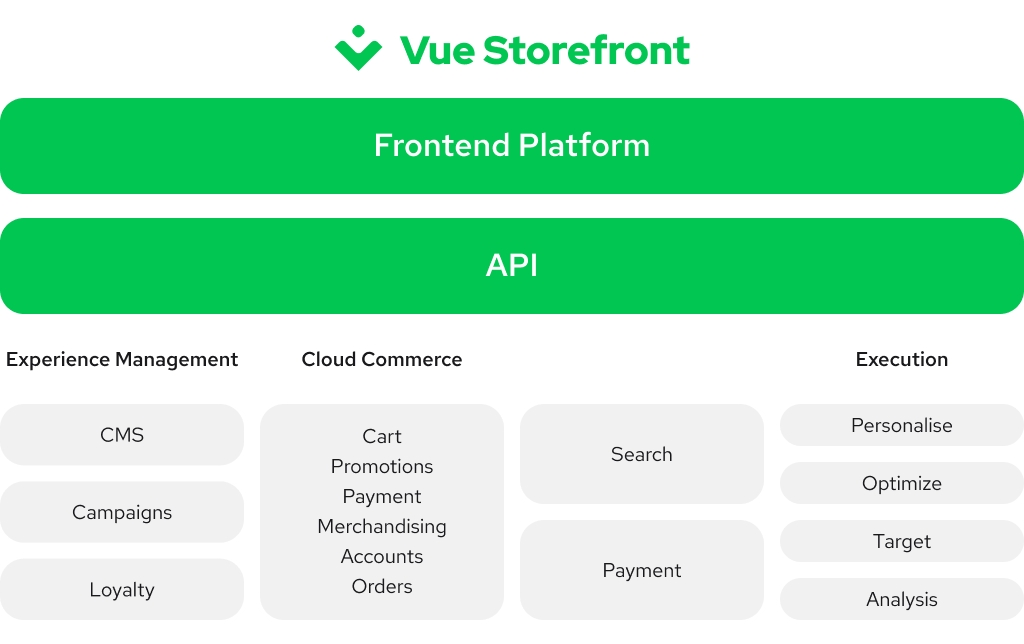
The client applications and the microservices don’t need to interact directly. Instead, they communicate through a gateway that sits in the middle. It acts as a reverse proxy, forwarding client requests to services. Authentication, SSL termination, and caching are just a few of the cross-cutting functionality it can provide.
The microservices API gateway is designed to handle partial failures properly. The failure of a single unresponsive microservice will not cause the entire request to fail. The ability of a microservices API gateway to recover from even minor issues is crucial.
When an application fails, it can:
- Take advantage of a previously cached response.
- Return an error code for critical information in the request’s primary concern.
- Provide an unassigned value.
- Rely on the top 10 hardware list.
Microservices architecture example: The SAGA
SAGA is an effective technique to maintain data consistency in a distributed structure without sacrificing ACID properties. SAGA is in charge of committing many comment transactions by allowing for rollbacks.
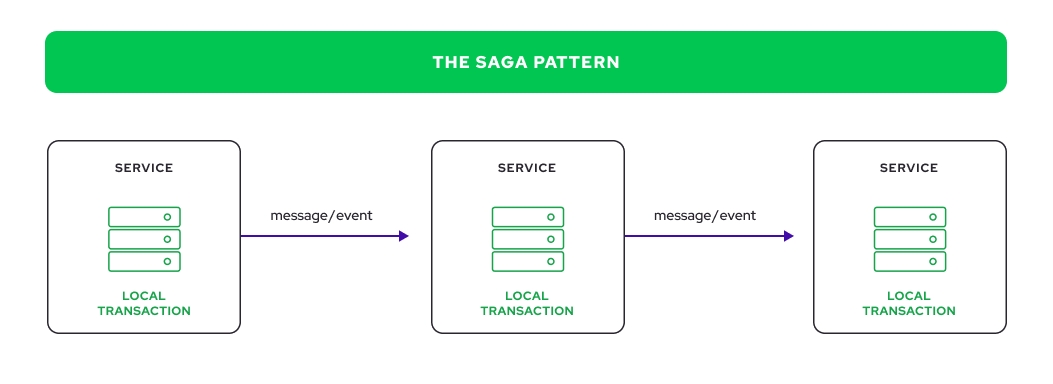
The SAGA may be represented in the orchestration or choreography.
In the choreography SAGA, there is no overall orchestration. Each service in the Saga performs its transaction and publishes events, one at a time. The other services react to and complete their responsibilities in response to these events. They may or may not publish additional events, depending on the situation.
Each service in the story performs its transactions and publishes events in the orchestration SAGA. The other services are notified of the occurrences and carry out their responsibilities.
- Advantages of using SAGA: It may be used to keep data consistency between services without being overly coupled.
- The disadvantage of using SAGA: The complexity of the SAGA design pattern for developers is high, and they are not used to writing sagas as conventional transactions.
Read more about microservice frameworks here.
Business benefits of microservice architecture in a nutshell
The most pressing modern business advantage of utilizing microservice architecture from a performance standpoint is increased UX metrics. They are built to comply with Google’s speed metrics, which are aligned with modern user expectations when shopping online. Below is a short summary of the vital benefits you can expect from a system compiled from microservices.
SEO impact:
Faster page and image loads improve SEO rankings, increasing organic traffic.
Conversion impact:
It places a strong emphasis on mobile UX, drastically improving your conversion rates.
Budget impact:
Development budgets are much smaller, allowing for bigger customer acquisition budgets.
Resources:
The best development talent is attracted to modern tech. They want to be at the forefront of the next BIG development.
Revenue:
Faster time to market, reduced dev costs, higher conversions, and optimized UX positively affect your revenue.
UX Performance:
Each application is smaller and built with a strong focus on modern UX performance and speed.
The Netflix Microservices example

Netflix utilizes an architecture of AWS microservices. Any communication between microservices happens over well-defined APIs, allowing polyglot development. It helps to keep the cloud cost-effective and eliminates a single point of failure, even if engineers modify numerous service areas simultaneously.
In August 2008, Netflix suffered a significant outage when still using a monolithic architecture and private data centers. That prompted Netflix to realize it needed to use a continuous deployment approach and decoupled applications to avoid future problems.
Microservices ensured that they didn’t experience service outages because it got them away from a single, vulnerable stack. It also allowed engineers at Netflix to play around with new design ideas without affecting the rest of the service’s performance.
It made Netflix more agile, resulting in Chaos engineering, Spinnaker, Global cloud, and the enormous growth the company has seen today. Each app running on the system is in charge of a discrete portion of Netflix’s vast operation.
For example, each of these functions is controlled by a distinct microservice:
- Make a list of movies that appear on the top menu.
- To give content relevant to a subscription level, check your current membership status.
- To recommend movies you may like, study your watch history.
- When it’s time to renew your Netflix membership, charge your credit card.
- Keep track of the most effective Content Delivery Appliance (CDA) in your region to see if one becomes clogged or fails.
- Automatically shift you to the best CDA with the best internet connection.
- Keep a digital version of the original high-quality files on AWS servers.
- Ensure that a different set of AWS servers converts the original copy into video qualities, formats, sizes, and audio that may play on all sorts of devices, including mobile devices, smart TVs, and gaming consoles.
- Determine what device you’re using to view Netflix and give the appropriate video format.
- Add copyright indicia to all files (Digital Rights Management)
These are only a handful of ways Netflix exploits a microservices architecture to its advantage. There are nearly 990 more options.
The Spotify microservices example

Another prominent example of microservices used to build an efficient system is Spotify. Spotify currently has over 75 million monthly active users. That’s a massive area to expand into.
Customers that use these applications don’t want to worry about the service, so the aim is to provide a hassle-free experience.
Here’s how Spotify deals with it:
- The network is divided into independent single-purpose microservices with autonomous development teams.
- Each microservice focuses on a distinct objective.
- Customer service is more consistent because these services operate in silos. As a result, customer support is less dependent on one another, and the firm can improve it without affecting the service.
- Furthermore, any new problem is confined to a single service and does not affect the entire system.
The Zadig & Voltaire microservices example
Zadig & Voltaire , a well-known fashion company, was one of the first merchants to employ Magento in 2008. For almost a decade, this platform, which established eCommerce standards, was an ideal match for Zadig & Voltaire. However, they decided to overhaul the frontend layer to unify its UX across markets.

The firm needed to increase performance and flexibility to offer tailored bargains on all desired markets, which was difficult without rebuilding the IT architecture and replacing some manual procedures with automation.
To achieve its ambitious objectives, the strategy called for using a microservices design approach that included:
- Decoupling the frontend from the backend, using Storefront UI .
- Adopting a contemporary Headless CMS .
- Embracing the potential of Progressive Web App ( PWA ) tech.
They chose Alokai, and - in addition to combining the benefits of native and desktop apps - brought along with it a slew of other advantages.
- Using data internationally but also differentiating content due to the geolocation system
- Synchronizing data with Magento automatically facilitates the management of daily tasks
- Improving SEO ranking by increasing performance and reducing bounce rates
Signing off
The microservices architecture pattern addresses many common challenges found in monolithic applications and service-oriented architectures. Because major application components are divided into smaller, separately deployed features, apps built on this architecture pattern are generally more robust, scalable, and capable of continuous delivery.
Share:
Share:
Frequently asked questions
More in Microservices
Ready to dive in? Schedule a demo
Get a live, personalised demo with one of our awesome product specialists.



















